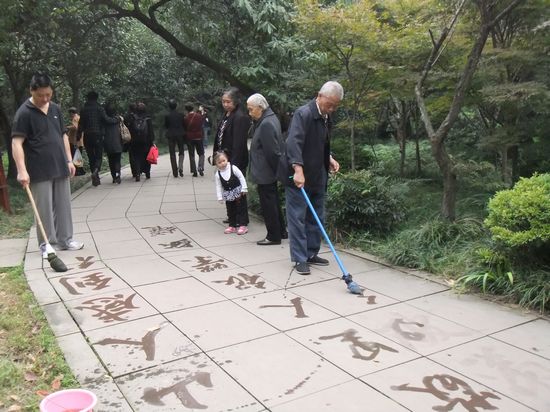For Interpersonal Connection

Calligraphic practice corresponds to a research of self accomplishment or improvement, this improvement modifying our perception of the world. Even if the image of the text is a highly sophisticated object, calligraphy is more a ritual thing and a lifestyle. The process of making is more important than the sign produced: a silent dialogue experiencing the subtle pleasure of discovering yourself through the movement of the brush and your own body. But here the practice is both individual and collective
Early morning parks are the stage of an essential moment of Chinese life where the need of the group, of sharing, expresses itself—notably amongst elderly people but also young adults and kids. The different practitioners of ground calligraphy refer, first of all, to the fact of being together, meeting, making friends, not staying at home, and sharing moments in a nice environment surrounded by nature. Talking about literature, commenting on a gesture or a calligraphic detail—this seems to be more important than the inscription on the ground itself. Even the debate is also interesting. This is the role of ground calligraphy for enhancing the interpersonal connection in city life.
What They Write
As for the content they write, it is typically embodied by the traditional value and the cultural essence, generally featuring the classic and easily-remembered literary lines, historic words and philosophical proverbs. The old people usually select the highlights of the classic poems, verses and prose of Tang and Song Dynasties, even the long words of sages in pre-qin period such as Lao Zi(老子), Confucius(孔子), Zhuang Zi(庄子), Mencius(孟子) and Xun Zi(荀子). Some may choose the popular words or poems of Chairman Mao, and this is surely a sign of history. In different regions, the content they white is also different. For instance, the ground calligraphers of Hangzhou popularly write the themed poems with West Lake, and the four-character titles of ten classic scenes of the West Lake
It is actually a folk hand-in-hand way to pass down the culture to younger generation. And such a way is also vividly effective, and the process of writing or educating is always surrounded by many people. It is a public cultural education, isn’t it? So it is not only writing for leisure, but a nationwide activity for healthcare, interpersonal connection, private education and cultural succession
The Tools for Writing

What the writers need just a relatively large square, a brush and one-third bucket of water. Generally, the brush is made by themselves, and there is no specific standard to regularize the making. Some people use sponge, some use rotted towel, some use woolen materials.
We recommend:
